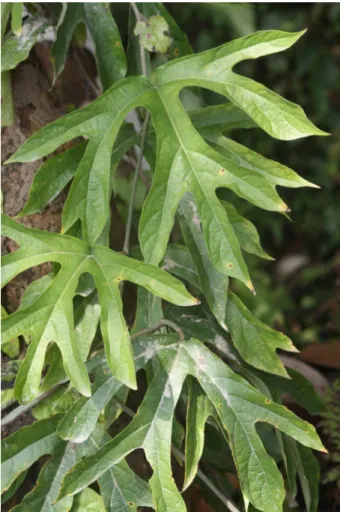Asian Journal of Conservation Biology, December 2012. Vol. 1 No. 2, pp. 138 -139 AJCB: SC0005 ISSN 2278-7666 ©TCRP 2012
Aristolochia platanifolia
(Klotz.) Duch. (Aristolochiaceae): A new record
for Assam, India
S. Baruah 1*, J. Sarma 2 & S.K.Borthakur3
1, 3
Department of Botany, Gauhati University, Guwahati– 781014, Assam, India
2
Logging Division, Tinsukia-786125, Assam, India
(Accepted November 15, 2012)
A ri st o l o c h i a p l a t a n i f o l i a ( Kl ot z . ) Du ch (Aristolochiaceae) is collected from Borjan, Padumani-Bherjan Wildlife Sanctury, Tinsukia district, Assam and is reported as new record for Assam.
Aristolochia L., is a core genus of the family Aristolochiaceae comprising of about 120 species, and is distributed in tropical and temperate Asia, Africa, Europe and America (Heywood, 1993; Mabberley, 1977). Several members of the genus have been used extensively in traditional Chinese and Indian medi-cines for the treatment of hypertension, leukocyte en-hancement, rheumatism, eczema, snakebite, festering wounds and as analgesic and diuretic and against tu-mours (Kupchan and Doscoth, 1962; Bensky et al., 1993; Thirumal et al., 2012). In India, Hooker (1886) reported only 8 species and Kanjilal et al. (1934) re-ported 4 species from Assam. However, the proper documentation of the genus in India is yet to be accom-plished.
During a recent floristic study undertaken in Tinsukia district of Assam the authors has collected some interesting specimens. After critical studies and scrutiny of literatures (Hooker, 1886) the collected specimen were identified as Aristolochia platanifolia (Klotzsch) Duch, a species hitherto not reported from Assam. However, Hooker (1886) mentioned its distri-bution as Eastern Himalaya, Mishmi Mountains, Kha-sia Mountains, Sikkim and E. Nepal. Scrutiny of litera-tures (Hooker, 1896; Kanjilal et al 1934, Paul et al., 2010) revealed that the species has not been reported from Assam earlier. A detail taxonomic account of the species along with distribution is provided here in the present communication. The voucher specimens are deposited in the Herbarium of Botany Department, Gauhati University (GUHB) for future reference.
Aristolochia platanifolia (Klotzsch) Duch., in DC., Prodr. 15(1): 437.1864; Hooker f., Fl. Brit. India 5:78.1886; Siphisia platanifolia Klotzsch. Monatsb. Akad. Wiss. Berl. 1859: 603.1859.
A stout climber with elongated rootstock and corky fissured bark of the stem . Leaves very broad, deeply digitately 3-lobed, glabous above,tomentose beneath, lobes glaucous, pubescent tomentose or woolly beneath, base rounded-cuneate or cordate, lobes very variable, lobules few, acute or acuminate; petiole 5-12 cm., often stout and twining .Flowers axillary and solitary, also in villous cymes on the old wood, peri-anth tomentose or villous, mouth obtusely 6-angled ,lips recurved, villous with purple papillose
hairs.Perianth yellowish with purple external veins, sac 2.5 cm. long, tube as long, golden yellow within, mouth 2.5 cm in diam. Capsule 10-15 by 2.5 cm in. diam., linear-oblong with 6 ribs divided by deep furrows (Figure 1 & Figure 2).
Flowering: Oct.-Nov. ; Fruiting: March-April
Specimen examined: Borjan, Padumani-Bherjan Wild-life Sanctury, Tinisukia District, Assam, J. Sarma & S. Baruah, 120, 121 (N 270 26/ 008//, E 95044/393//, EL about 38 m msl), Forest Department, Assam and Her-barium of Botany Department, Gauhati University (GUBH).
Distribution: India: Assam, Sikkim; Nepal, Bhutan
*Corresponding Author’s E-mail: sanjibbaruah9@gmail.com
138
Baruah et al.
REFERENCES
Bensky. D., Gamble, A., Kaptchuk,T. and Bensky, L.L. 1993. Chinese Herbal Medicine: Materia Medica. ( Rev. edn). Eastland Press. Washington, U. S. A. Heywood, V.H. 1993. Flowering Plants of the World.
Oxford University Press. New York.
Hooker, J.D. 1886. Aristolochiaceae. Flora of British India. Vol .5. L. Reeve & Co. Ltd.London.
Kanjilal, U.N., A. Das, Kanjilal, P.C. and Dey, R.N. 1934. Flora of Assam. Vol. II. Govt. Of Assam. Shillong.
Kupchan ,S.M., Doscoth, R.W. 1962. Tumor inhibitors (I) aristolochic acid, the active principle of Aris-tolochia indica J. Med. Pharm. Chem. 5:657-659. Mabberley,D.J.M.1997. The Plant-Book.Cambridge
University Press,Cambridge,U.K.
Paul, S., Devi, N. and Sarma, G.C. 2010. Diversity of some medicinally important species of Aris-tolochia Linnaeus (ArisAris-tolochiaceae) in Assam, India. Pleione 4(2).250-255.
Thirumal, M.,Vadivelan, R.,Kishore, G., Brah-maji,V.S . 2012. Aristolochia bracteolata: An Overview on Pharmacognostical, Phytochemical and Pharmacological roperties. Crit. Rev. Pharm. Sci. 1: 66-78.
AJCB Vol. 1 No. 2, pp. 138 - 139, 2012 139

